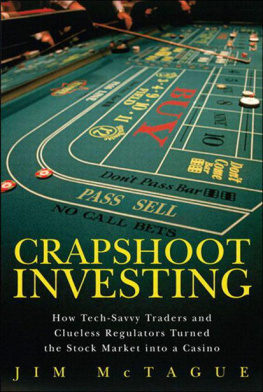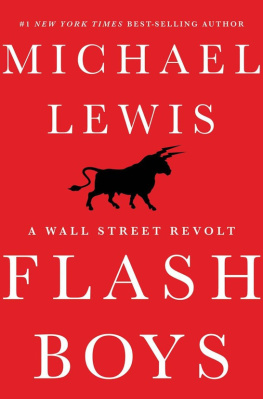
Crapshoot Investing: How Tech-Savvy Traders and Clueless Regulators Turned the Stock Market into a Casino
Jim McTague
Vice President, Publisher Tim Moore
Associate Publisher and Director of Marketing Amy Neidlinger
Executive Editor Jim Boyd
Editorial Assistant Pamela Boland
Development Editor Russ Hall
Operations Manager Gina Kanouse
Senior Marketing Manager Julie Phifer
Publicity Manager Laura Czaja
Assistant Marketing Manager Megan Colvin
Cover Designer Chuti Prasertsith
Managing Editor Kristy Hart
Project Editor Anne Goebel
Copy Editor Gill Editorial Services
Proofreader Water Crest Publishing
Senior Indexer Cheryl Lenser
Senior Compositor Gloria Schurick
Manufacturing Buyer Dan Uhrig
2011 by Pearson Education, Inc.
Publishing as FT Press
Upper Saddle River, New Jersey 07458
This book is sold with the understanding that neither the author nor the publisher is engaged in rendering legal, accounting, or other professional services or advice by publishing this book. Each individual situation is unique. Thus, if legal or financial advice or other expert assistance is required in a specific situation, the services of a competent professional should be sought to ensure that the situation has been evaluated carefully and appropriately. The author and the publisher disclaim any liability, loss, or risk resulting directly or indirectly, from the use or application of any of the contents of this book.
FT Press offers excellent discounts on this book when ordered in quantity for bulk purchases or special sales. For more information, please contact U.S. Corporate and Government Sales, 1-800-382-3419, .
Company and product names mentioned herein are the trademarks or registered trademarks of their respective owners.
All rights reserved. No part of this book may be reproduced, in any form or by any means, without permission in writing from the publisher.
Printed in the United States of America
First Printing March 2011
Pearson Education LTD.
Pearson Education Australia PTY, Limited.
Pearson Education Singapore, Pte. Ltd.
Pearson Education Asia, Ltd.
Pearson Education Canada, Ltd.
Pearson Educatin de Mexico, S.A. de C.V.
Pearson EducationJapan
Pearson Education Malaysia, Pte. Ltd.
Library of Congress Cataloging-in-Publication Data:
McTague, Jim, 1949
Crapshoot investing : how tech-savvy traders and clueless regulators turned the stock market
into a casino / Jim McTague.
p. cm.
ISBN 978-0-13-259968-9 (hardback : alk. paper)
1. Investment analysisUnited States. 2. Stock exchangesLaw and legislationUnited
States. 3. Electronic trading of securities. 4. StocksLaw and legislationUnited States.
5. Capital marketUnited States. I. Title.
HG4529.M397 2011
332.64273dc22
2010051301
ISBN-10: 0-13-259968-6
ISBN-13: 978-0-13-259968-9
To my wife, Rachel, for her understanding, help,
and encouragement.
Contents
Acknowledgments
I want to thank my most memorable college professor and lifelong friend, Francis Burch, S.J., a brilliant scholar and author who encouraged me to become a columnist and an author.
This book was produced under a tight deadline to bring very important information to the attention of the investing public. I would not have been able to tackle the project without the encouragement of my colleagues at Barrons: Editor and President Edwin Finn; Managing Editor Richard Rescigno; and Assistant Managing Editor Phil Roosevelt. I also owe thanks to my officemate Tom Donlan, our editorialist and the author of several books, for his suggestions, especially those regarding Harvey Houtkin.
Chris Anderson, one of the smartest men on Wall Street, provided me with insights about the changing nature of the equities market. Ken Safian, another Wall Street legend, offered invaluable insights about high-frequency trading. Jamie Selway of Investment Technology Group LLC shared insights on market structure.
Will Ackworth of the Futures Industry Association was exceedingly generous in sharing his knowledge about the history of the commodities markets. Wayne Lee of NASDAQ, Ray Pellecchia of the NYSE Euronext, John Heine of the Securities and Exchange Commission, and Dan Chicoine of TD Ameritrade were especially helpful in connecting with market experts.
I also want to thank the many lawyers, regulators, and traders who spoke to me about market structure and high-frequency trading on deep background.
Finally, I offer special thanks to my daughter Alex, a patent litigator, and Bob Schewd of WilmerHale, a brilliant literary contract attorney, for assisting me in my negotiations with the publisher.
About the Author
Jim McTague has been Washington Editor of Barrons Magazine since 1994a post that gives him privileged access to key players in Washington and on Wall Street. A credentialed White House and Capitol Hill correspondent, hes covered every administration since the first President Bush. McTague has appeared on NBC, CNN, CNBC, MSNBC, FOX, and is a frequent guest on FOX Business News. His extensive analysis of the underground economy in 2005 exploded the myth that illegal aliens were a small percentage of the U.S. population, triggering todays border security debate. McTague holds an MA in English from Pennsylvania State University and a BS in English from St. Josephs University in Philadelphia.
Introduction
The stock market has changed radically since 2005, yet few persons realized the greatness of the seismic shift until May 6, 2010, when the major averages collapsed over the course of 10 minutes. The public suddenly realized that a venue designed to efficiently move capital from investors to the most promising enterprises had become as risky as a Las Vegas casino. This book is the story of well-intentioned but disastrously wrong-headed decisions by Congress and securities regulators that resulted in the destruction of a great American institution and possible long-lasting damage to the entire U.S. economy. Fixing this mess is without a doubt the most important challenge for U.S. policy makers in the years ahead, yet few of them understand this. They are still looking backward at the credit crisis of 2007 to 2008 and fail to see the bigger threat that is right before their eyes.
Just prior to May 6 during the first quarter of 2010, the all-clear siren sounded for shell-shocked Wall Street investors. All seemed well with the stock market. The major stock indexes, which had hit 12-year lows in March 2009 in the midst of the turbulent Great Recession, miraculously recovered by 74% the same month a year later. Investors once again were able to look at the returns in their retirement accounts without becoming physically ill. Confidence in the stock market, which had been badly shaken during the market meltdown of the previous two years, began to strengthen. In April 2010, retail investors began shifting money from safe havens like gold, commodities, and treasury bonds into equities and equity mutual funds, which was good news for cash-starved American enterprises.
An intraday move of 3% in the Standard & Poors (S&P) 500 is considered unusually large. According to Birinyi Associates, a stock market research group, there were 42 days with 3% moves in 2008 compared to 1 day in 2007 and 0 days from 2004 through 2006 (see ).
Next page











